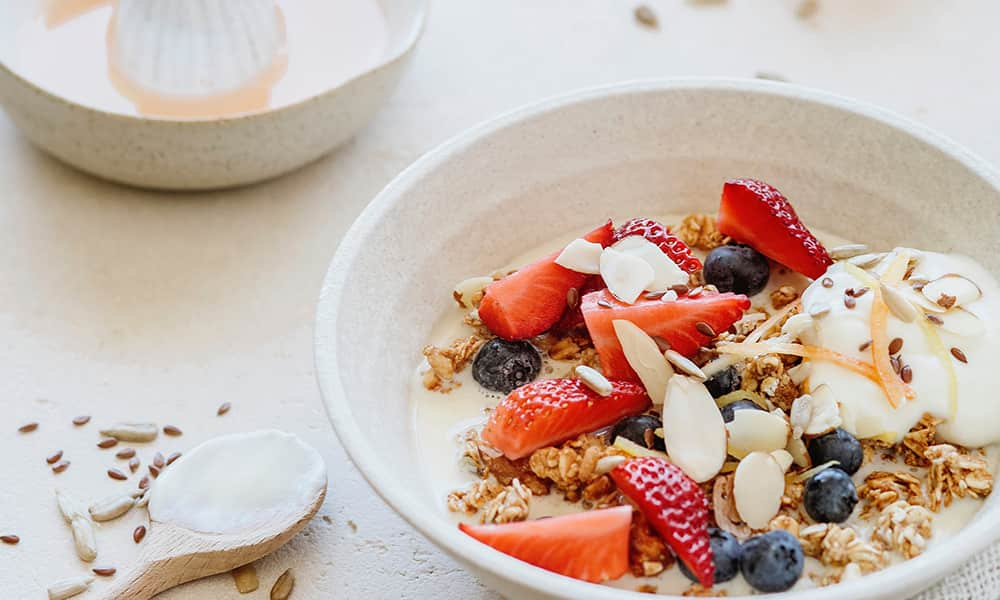We have a better understanding now than we’ve ever had about the digestive system and the good bacteria needed to maintain it properly. While probiotics have gained popularity in recent years, there are a number of other types of bacteria that are required to keep your gut health humming along.
There’s a number of ways to include bacteria in your diet, from fruits and veggies to legumes and wholegrains, which makes it easy to eat your way to good gut health. We explore some of the main types of digestive bacteria and how you can look after them to keep your gut health in tip-top shape.
Bacteroidetes
This group of gut bugs plays a key role in breaking down undigested fibres from plant-based foods like wholegrains, legumes, fruits and vegetables that make their way to the colon.
These fibres are broken down by the gut bugs, which produce enzymes to chop up the long chains and ferment them into short-chain fatty acids like butyrate, propionate and acetate, which are made exclusively by bacteria.
Butyrate is beneficial to the body, as it provides an energy source for the “friendly” bacteria (Lactobacillus) living in the colon, as well as the cells lining our intestines. It also controls the proliferation of cells thought to possess anti-carcinogenic and anti-inflammatory properties.
Firmicutes
This group of bacteria is associated with an increased risk of obesity because they regulate how much fat we absorb. Studies have shown that a typical Western diet high in refined carbohydrates and sugar have higher amounts of Firmicutes.
By comparison, populations who feed on the Mediterranean-style plant-based diet (such as fruits, whole grains, olive oil, nuts and vegetables) tip the balance in favour of Bacteroidetes, reducing the overall risk of chronic disease.
Probiotics
Many types of bacteria are classified as probiotics, but the most common species include Lactobacillus and Bifidobacterium. These differ as they’re made up of different strains of bacteria and are recommended for different clinical conditions.
However, generally speaking, probiotics are live “friendly” bacteria that are found naturally in the gut, as well as in selected foods and supplements prepared by bacterial fermentation. These friendly bugs help balance the overall gut flora and crowd out “bad” bacteria.
Research has also shown that probiotics may support digestive health, such as reducing the symptoms of irritable bowel and immunity.
Prebiotics aren’t bacteria
Prebiotics are the ingredients friendly gut bacteria use as fuel to nourish their own growth and activity. In other words, they’re the meal choice for probiotics. There are many types of prebiotic fibre: non-fermentable and fermentable, with the latter the type of fibre the probiotic bacteria prefer.
Fermentable fibres, such as inulin and resistant starch, can be found naturally in plant-based foods including whole grains, cereals, bananas, brown rice, legumes, pulses, onions, leeks, artichokes, garlic and barley.
Unfortunately, today’s Western diet is exceedingly fibre-poor, with two out of three Australian adults currently not meeting their adequate daily intake for dietary fibre (25g for women and 30g for men).
That means we’re missing out on the health benefits derived from the various fibre types that are naturally present in plant-based foods. On top of this, less than 4% of the population consumes enough vegetables and legumes every day.
Eat your way to good gut health
— Include a wide range of plant-based foods in your diet. A healthy gut has a diverse community of microbes, each of which prefers different forms of dietary fibre and resistant starch. Fruit, vegetables, legumes, onions, leeks, garlic, Jerusalem artichokes, chicory root, asparagus, nuts and wholegrains feed healthy bacteria.
— Choose whole grains over refined grains, such as wholemeal pasta or bread, wholegrain breakfast cereals, barley, sourdough, brown rice or quinoa.
— Enjoy probiotic-rich foods, such as fermented foods (kimchi, kefir and sauerkraut), to encourage more microbes to grow. However, for most people, the easiest way to incorporate probiotics and to keep it up regularly is by eating good-quality “live” probiotic yoghurt in addition to the added dairy protein and calcium.
— Sometimes a supplement is worthwhile to really boost the number of probiotics you’re getting. However, the number of bacteria present also matters as does the frequency with which you take them – in other words, you have to keep taking them, as the odd one won’t do any good.
Read more stories from The Latch and follow us on Facebook.

